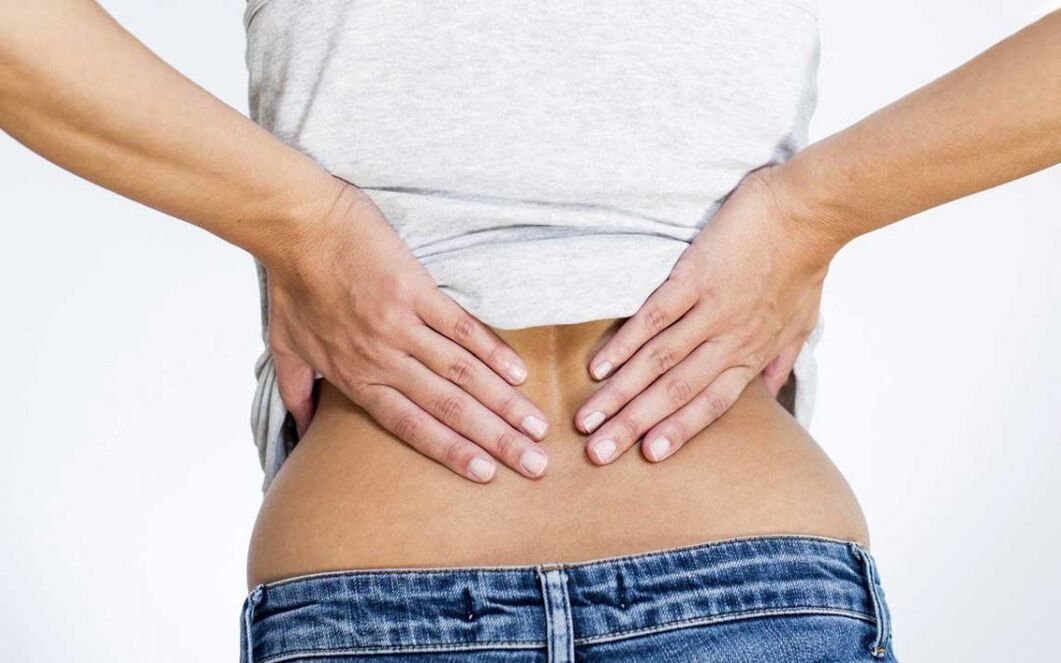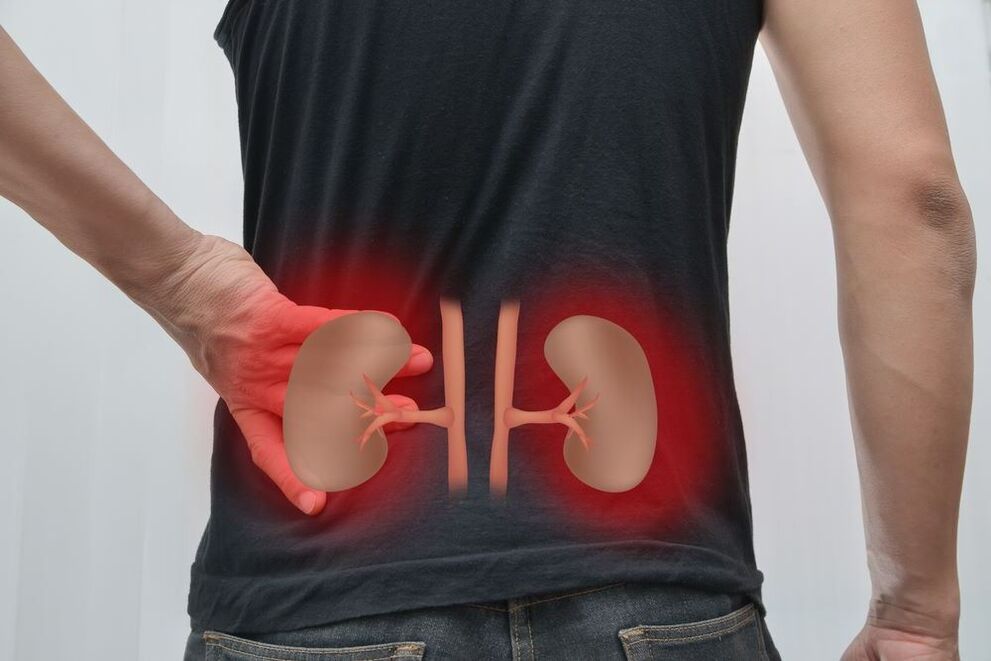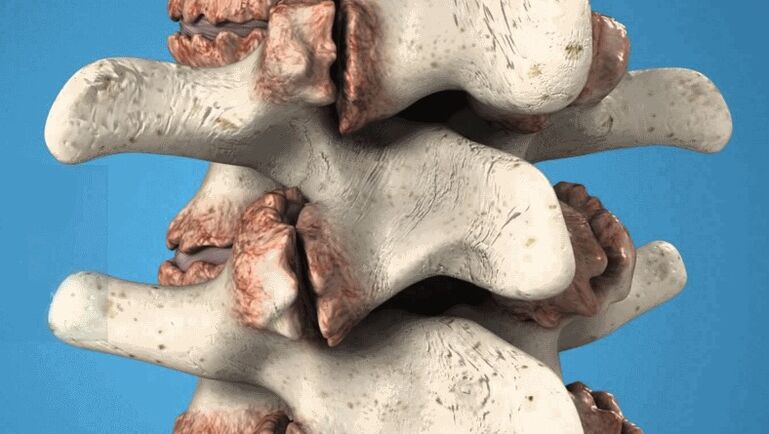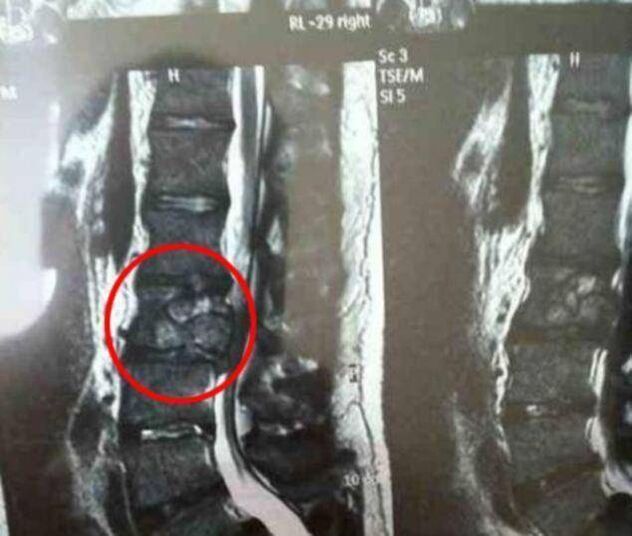
There is practically no person who would not experience lower back pain at least once in his life. This is how we pay for walking upright and our everyday habits.
In addition to injuries that can affect the spine, its muscles, nerves and ligaments, it should be remembered that sometimes the back hurts the lower back with internal diseases - diseases of the kidneys, gastrointestinal tract and female genital organs.
Symptoms of lower back pain can range from dull to sharp. The pain may go away on its own or become chronic (the symptom has been present for more than three months).

Dangerous! You should immediately consult a doctor if:
- pain in the lower back occurred suddenly after an obvious back injury;
- the temperature has risen sharply, there are vegetative disorders, loss of consciousness, sweating, difficulty breathing;
- involuntary emptying of the bowels and bladder occurs;
- there is numbness in the groin area;
- there was weakness in the lower limbs, their paresis or paralysis, decreased sensitivity;
- pain is given to the stomach and greatly increases when coughing or sneezing;
- symptoms appeared against the background of severe weight loss, long-term use of steroids, immunodeficiency;
- in the family history there were cases of cancer, inflammatory or degenerative diseases of bone and cartilage tissue.
Why does the back hurt in the lower back?
Myofascial pain
A muscle tension or spasm can develop gradually or occur suddenly. With a high load, injuries affect not only muscle fibers, but also the ligament apparatus and fascia.
Muscle pain in the lower back occurs after:
- lifting heavy weights or overexerting yourself at work or playing sports;
- play sports from time to time. Muscles are especially vulnerable if you are inactive during the work week and then spend hours at the gym on the weekend;
- a sharp increase in the weight of one's own body, behind which muscles do not have time to grow;
- prolonged sitting or standing in an uncomfortable position;
- daily carrying of a bag in one hand or over the shoulder;
- attitude disorders. The spine performs its best supportive and protective function when you are not leaning down. The muscles in the lower back experience the least stress when you sit with good support under the lower back, and in a standing position the weight is distributed evenly on both legs.
If the back hurts after a bruise, fracture, sprain, hypothermia, an infectious disease or an established helminthic invasion, then myositis (inflammation) of the muscles of the lower back can be suspected. Severe pain is constantly present due to inflammation of the muscle fibers, "knots" are felt in the muscles - places of spasms. Inflammation can be acute or take a chronic form. In the case of a long illness, the pain is unstable, worsens when lying down or sitting for a long time, in the late afternoon or when the weather changes. Touching the muscles causes a feeling of soreness and discomfort, the muscles of the lower back are in constant tension, inflammatory edema is formed, the temperature rises locally and at the level of the whole organism.
With muscle spasms, the roots of the spinal nerves are violated, so attacks often resemble a picture of sciatica or sciatica - there are burning strong pains along the back of the thigh and lower leg, the limbs become numb, they lose sensitivity. The pronounced muscle tone in myositis makes the patient take a forced position, he walks and lies hunched over, moves on bent legs.
How to treat muscle pain in the spine? Nonsteroidal anti-inflammatory drugs and analgesics are used to eliminate inflammation and pain. Medicines can be taken in the form of tablets, ointments, injections, transdermal patches with a gradual release of active substances. Irritating and warming ointments are also used, which reflexively increase blood flow to the muscles in the lower back. A greater volume of inflowing blood contributes to the washing out of the products of inflammation and tissue breakdown.
The reduction of inflammatory edema is facilitated by injections of corticosteroids and vasoconstrictive drugs.
If the cause of myositis is an infection or poisoning of the body with worm toxins, antibiotics or anthelmintic drugs are initially used. In this case, heat salves or compresses cannot be used.
Spinal cord diseases involving nerve endings
In the lower back, the vertebrae are separated by elastic discs of cartilage, which protect the spine from damage, but are themselves subject to wear and aging.
Normally, the disc is a jelly-like nucleus pulposus surrounded by a denser layer of annulus fibrosus. The elasticity of the core is due to its ability to bind and retain water: when the load increases, it collects water, and elasticity increases, when the pressure decreases, the core releases water and becomes flatter.
Osteochondrosis in the vertebral region develops when the intervertebral discs are malnourished (their "drying out") or with excessive local stress. Most often, pain in the lower back is due to the fact that the lower poles of its intervertebral discs bear the greatest load when sitting, when lifting weights in front of them. At the same time, tears are formed, displacements in the discs, the vertebral ligaments are damaged, there is a constant aching pain, pulsation.
Pain in the spine has several development mechanisms:
- violation of microcirculation in the tissues around the spine and especially in the spinal canal, the formation of congestion and edema. Such conditions develop against the background of hypothermia, overheating, inflammatory processes.
- degenerative processes in the fixing ligaments of the spine. An increase in the mobility of the vertebrae leads to their slight displacement and non-physiological compression, which causes violation of nerves, blood vessels and the formation of hernias.
- axial compression of the vertebrae when lifting weights or damaging them during excessive rotation (turning).
- aseptic inflammation. The destruction of the nucleus leads to the release of sensitizing factors in the spinal canal. There is irritation of the nerve endings, which causes a spasm in the muscles that impinge on the neighboring vertebrae - above and below the hernia. Gradually, the reaction covers the entire lower back and leads to any movement causing a sensation of pain.
A weakened disc can rupture, resulting in a bulging, protrusion or prolapse of the nucleus and eventually a herniation. The appearance of a hernia puts pressure on the spinal cord and spinal nerve roots. Under such conditions, a throbbing pain in the lower back appears sharply, which diverges along the strangled nerve. The most well-known cases of compression of the sciatic nerve (sciatica), which are manifested by sharp pain along the back of the thigh and lower leg, numbness in the limb from the side of the hernia, muscle weakness, involuntary tucking of the leg.
Pain in the lumbar spine worsens in a sitting and standing position, when turning, tilting. Often there is a protective muscle reaction - a painful contraction of the muscles (formation of rolls) on both sides of the spine, which isolates the department from unnecessary movement. Osteochondrosis subsequently leads to the appearance of sciatica (inflammation of the roots of the spinal nerves).
The radicular syndrome is dangerous when the nerves in the lower back, which are responsible for the innervation of the internal organs (the horns of the cauda equina), are pinched. At the same time pain is given to the stomach, the function of the bladder and intestines is disturbed, there are problems with potency in men and gynecological diseases in women.
Many patients, due to the fact that the lower back hurts a lot, take pain-relieving positions - they deviate the body to the left, if the right side hurts, lie on the right side. If the hernia is on the left. Also characteristic is the appearance of severe pain when pressing on a hernia in the intervertebral space (ring symptom).
How to treat if your back hurts with osteochondrosis:
- during a pain attack, you can take an anesthetic position - lie on your back and put a roll under your knees. It is also recommended to sleep on a hard surface;
- from painkillers, NSAIDs can be taken orally or as injections on both sides of the spine in the lumbar hotel;
- use local irritants as distraction therapy - mustard plasters, iodine mesh, pepper plasters and ointments;
- eliminate myotic spasm through manual therapy, acupuncture, vacuum massage, reflexology, gymnastics;
- during the attenuation of the acute period, mud treatment, ozocerite, heating can be used.
Treatment of radicular syndrome pain includes:
- provision of bed rest, lumbar traction (dry or under water);
- the use of novocaine blockades at the site of the violation, the use of NSAIDs or weak opiates;
- physiotherapy - microcurrent stimulation, electrophoresis with analgesics.
Indications for surgery are constant acute pain and reduced function of internal organs, development of paralysis of the limbs, sequestration of a hernia in the spinal canal.
Degenerative inflammatory lesions
Spondylarthrosis (inflammation of the facet joints of the vertebrae) occurs with degeneration, a decrease in the height and volume of the intervertebral discs. Pain in the lower back occurs due to overstretching of the capsule and increased pressure on the surface of the intervertebral joints. Pain causes the patient to bend more in the lower back and thus increases the overload of the intervertebral joints. In particular, discomfort in the lower back is aggravated by wearing shoes with heels, walking for a long time, descending from elephants, positions when the body deviates backwards, for example, when looking at something above the head.
In patients with this diagnosis, stiffness in the lower back is noted in the morning, the pain increases during the day or after exercise. It has a diffuse character, and it is difficult to clearly show the boundaries: discomfort is determined in the gluteal muscles, inguinal region, abdomen and in the scrotum in men. This spondyloarthrosis differs from radicular syndrome when you can pinpoint the source of pain.
What to do to relieve pain? It usually helps to take a lying position by bending the legs at the hip and knee joints.
Their medications are preferred non-steroidal anti-inflammatory drugs and non-narcotic analgesics.
Muscle relaxants are also added as they relieve muscle tension and improve spinal mobility.
Psychotherapy has a positive effect, as chronic pain introduces the patient into a state of depression.
Unlike osteochondrosis, spondylosis affects the fibrous ring of the intervertebral disc and the anterior longitudinal ligaments more. With this disease, calcification of connective tissue structures occurs with the formation of growths along the edges of the vertebrae - osteophytes. These formations cause a violation of the microcirculation near the nerve roots and lead to the fact that the back hurts in the lower back, and the mobility of this department is also limited.

Vertebral osteophytes are pathological growths that damage nerves and blood vessels.
The treatment is usually conservative with the use of anti-inflammatory drugs, analgesics, vitamins. A good effect is given by electrophoresis with novocaine, lidase, manual therapy, physiotherapy (amplipulse, laser installation, shock wave therapy to destroy compressed elements and increase spinal mobility).
Note! In the advanced stage, osteophytes do not resolve. While their size is small, the treatment is aimed at eliminating inflammation, pain, improving metabolism. If the back doesn't hurt much, then nothing is done about the growths. If osteophytes cause persistent pain or are large, they can be removed during surgery.
Diseases of a tumor nature
Lumbar pain can arise from compression of the spinal cord by a tumor from the outside (extramedullary formations) and from the inside (intramedullary, originating from the cerebrospinal substance itself).
Cells of various tissues can grow pathologically:
- fatty - a lipoma is formed;
- nerve roots - neuroma;
- spinal cord masses - hemangioma;
- accessory tissue - glioma;
- bone tissue - osteosarcoma;
- cartilage - chondrosarcoma.
The tumor process, especially malignant, is characterized by a pain syndrome reminiscent of sciatica (it can be unilateral and bilateral), a general worsening of the patient's condition and exhaustion.

If the pathology affects the area of I-IV lumbar vertebrae, there is a burning pain in front and on the sides of the upper thigh, incomplete paralysis of this area.
With a lesion in the region of IV lumbar - II sacral segments, numbness in the paragenital region, reduced motor and sensory innervation of the gluteal muscles, rear thigh, calf, fecal and urinary incontinence are noted.
A pronounced disturbance in the function of the pelvic organs occurs with a neoplasm in the region of the V-III sacral vertebrae. The patient suffers from sexual impotence or menstrual disorders, constipation or faecal and urinary incontinence.
Treatment of tumors is specific, pain relievers and cancer drugs are prescription drugs.
As you can see, lower back pain is usually caused by musculoskeletal pathologies. They can be diagnosed by clinical signs and research data, the main task of which is to correctly determine the nature of the disease and not confuse it with oncological causes, diseases of internal organs or trauma. If you experience pain in the lower back, we recommend that you always seek advice from a neurologist or orthopedist.

















































